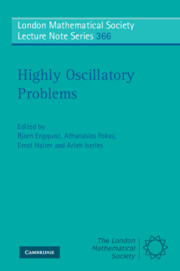Book contents
- Frontmatter
- Contents
- Preface
- 1 Oscillations over long times in numerical Hamiltonian systems
- 2 Highly oscillatory quadrature
- 3 Rapid function approximation by modified Fourier series
- 4 Approximation of high frequency wave propagation problems
- 5 Wavelet-based numerical homogenization
- 6 Plane wave methods for approximating the time harmonic wave equation
- 7 Boundary integral methods in high frequency scattering
- 8 Novel analytical and numerical methods for elliptic boundary value problems
7 - Boundary integral methods in high frequency scattering
Published online by Cambridge University Press: 07 September 2011
- Frontmatter
- Contents
- Preface
- 1 Oscillations over long times in numerical Hamiltonian systems
- 2 Highly oscillatory quadrature
- 3 Rapid function approximation by modified Fourier series
- 4 Approximation of high frequency wave propagation problems
- 5 Wavelet-based numerical homogenization
- 6 Plane wave methods for approximating the time harmonic wave equation
- 7 Boundary integral methods in high frequency scattering
- 8 Novel analytical and numerical methods for elliptic boundary value problems
Summary
Abstract
In this article we review recent progress on the design, analysis and implementation of numerical-asymptotic boundary integral methods for the computation of frequency-domain acoustic scattering in a homogeneous unbounded medium by a bounded obstacle. The main aim of the methods is to allow computation of scattering at arbitrarily high frequency with finite computational resources.
Introduction
There is huge mathematical and engineering interest in acoustic and electromagnetic wave scattering problems, driven by many applications such as modelling radar, sonar, acoustic noise barriers, atmospheric particle scattering, ultrasound and VLSI. For time harmonic problems in infinite domains and media which are predominantly homogeneous, the boundary element method is a very popular solver, used in a number of large commercial codes, see e.g. [CSCVHH04]. In many practical applications the characteristic length scale L of the domain is large compared to the wavelength λ. Then the small dimensionless wavelength λ/L induces oscillatory solutions, and the application of conventional (piece-wise polynomial) boundary elements for this multiscale problem yields full matrices of dimension at least N = (L/λ)d-1 (in ℝd). (Domain finite elements lead to sparse matrices but require even larger N.) Since this “loss of robustness” as L/λ→∞ puts high frequency problems outside the reach of many standard algorithms, much recent research has been devoted to finding more robust methods.
- Type
- Chapter
- Information
- Highly Oscillatory Problems , pp. 154 - 193Publisher: Cambridge University PressPrint publication year: 2009
- 12
- Cited by



